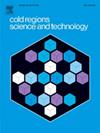A model for predicting the mechanical properties of frozen moraine soil under impact loading
IF 3.8
2区 工程技术
Q1 ENGINEERING, CIVIL
引用次数: 0
Abstract
The frozen moraine soil is geographically distributed across the Qinghai-Tibet Plateau and its surrounding areas, serving as a fundamental substrate for engineering projects such as the Sichuan-Tibet Railway and the China-Pakistan Highway. As an economical and efficient construction technique, blasting is a commonly employed in these projects. Understanding the dynamic mechanical response, damage, and failure characteristics of moraine soil is crucial for accurately predicting the impact of blasting. Therefore, this study utilizes the Split Hopkinson Pressure Bar (SHPB) equipment to conduct impact tests on moraine soil under different temperatures and strain rates. Additionally, a model for predicting the dynamic mechanical response of frozen moraine soil has been proposed based on peridynamic theory, decohesion damage theory, and the ZWT model, in which the debonding damage and the adiabatic temperature rise are considered. This model focuses on considering the bonds between different substances within frozen moraine soil. By defining the mechanical response of these bonds, the impact deformation mechanism of frozen moraine soil is unveiled. Within this, the modeling of ice-cemented bonds contributes to a deeper understanding of the crack propagation characteristics in frozen moraine soil. The model prediction results demonstrate its capability to predict various aspects of the dynamic response of frozen moraine under impact loading, including the macroscopic stress-strain behavior, the mesoscopic crack initiation and propagation, and the influence of adiabatic temperature rise on the damage mechanism, as well as evaluate the damage state of frozen moraine soil under impact loading.
冲击荷载作用下冰碛土力学特性的预测模型
冰碛土在地理上分布于青藏高原及其周边地区,是川藏铁路、中巴公路等工程项目的基础基质。爆破作为一种经济高效的施工技术,是此类工程中常用的施工技术。了解冰碛土的动态力学响应、损伤和破坏特征是准确预测爆破影响的关键。因此,本研究利用分离式霍普金森压杆(SHPB)设备对冰碛土进行了不同温度和应变速率下的冲击试验。此外,基于周动力理论、脱粘损伤理论和考虑脱粘损伤和绝热温升的ZWT模型,提出了冰碛土动态力学响应预测模型。该模型侧重于考虑冰碛土中不同物质之间的联系。通过定义这些键的力学响应,揭示冻结冰碛土的冲击变形机理。其中,冰胶结键的建模有助于更深入地了解冻结冰碛土中的裂纹扩展特性。模型预测结果表明,该模型能够预测冰碛土在冲击荷载作用下的宏观应力-应变行为、细观裂纹萌生与扩展、绝热温升对损伤机理的影响等动态响应,并能评价冰碛土在冲击荷载作用下的损伤状态。
本文章由计算机程序翻译,如有差异,请以英文原文为准。
求助全文
约1分钟内获得全文
求助全文
来源期刊

Cold Regions Science and Technology
工程技术-地球科学综合
CiteScore
7.40
自引率
12.20%
发文量
209
审稿时长
4.9 months
期刊介绍:
Cold Regions Science and Technology is an international journal dealing with the science and technical problems of cold environments in both the polar regions and more temperate locations. It includes fundamental aspects of cryospheric sciences which have applications for cold regions problems as well as engineering topics which relate to the cryosphere.
Emphasis is given to applied science with broad coverage of the physical and mechanical aspects of ice (including glaciers and sea ice), snow and snow avalanches, ice-water systems, ice-bonded soils and permafrost.
Relevant aspects of Earth science, materials science, offshore and river ice engineering are also of primary interest. These include icing of ships and structures as well as trafficability in cold environments. Technological advances for cold regions in research, development, and engineering practice are relevant to the journal. Theoretical papers must include a detailed discussion of the potential application of the theory to address cold regions problems. The journal serves a wide range of specialists, providing a medium for interdisciplinary communication and a convenient source of reference.
 求助内容:
求助内容: 应助结果提醒方式:
应助结果提醒方式:


